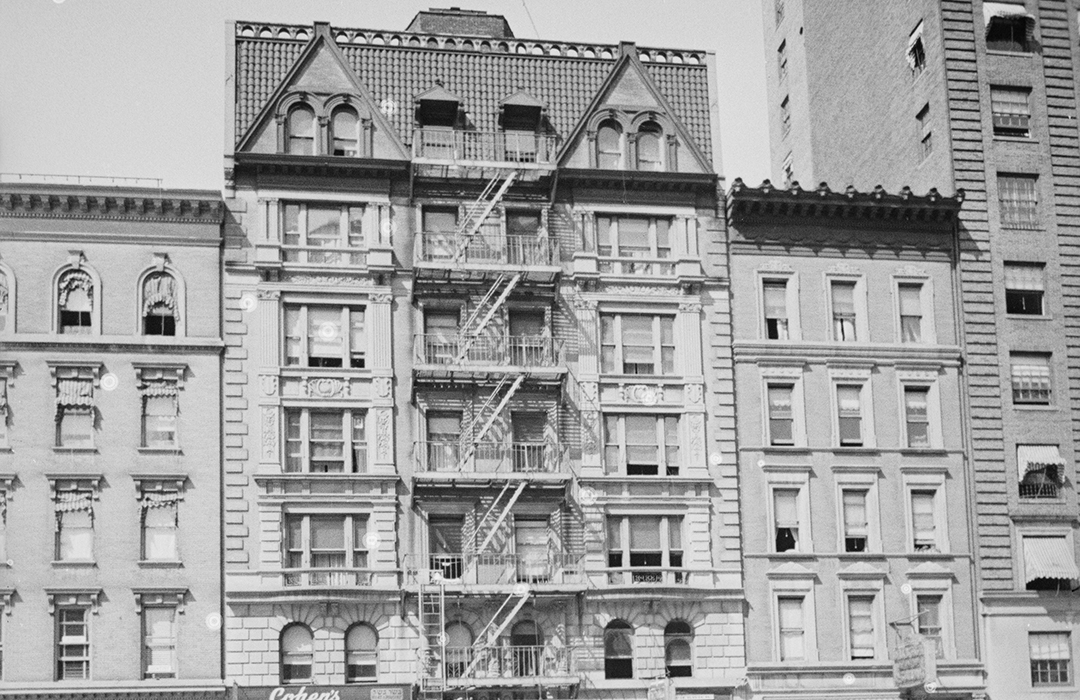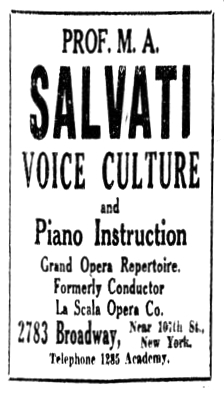
The Trouville Apartments
by Tom Miller
In 1899 real estate developers H. L. & L. Ottinger completed construction on their upscale apartment house, The Trouville, at 2783 and 2785 Broadway. Designed by Henry Andersen, it was technically two buildings, separated by a firewall, each with a store at ground level. Andersen had designed the mirror image structures in the German Renaissance style, the top story taking the shape of a tall mansard fronted by twin tables and two hooded dormers.
An advertisement in September 1899 touted, “The beautiful Riverside Drive is but one block away and can be seen from the roof garden of the Trouville, constructed for the exclusive use of tenants.” Each of the eight-room apartments (two per floor) had a “tile bathroom with shower.” The up-to-the-date amenities included gas fireplaces with artificial logs, parquet flooring in the dining rooms, parlors and libraries, and electric lights.
Among the early residents were the family of Joseph B. Mally. He was a partner in the garment manufacturing firm of Mally & Herman. Joseph and his wife had a horrific scare in late spring 1905. Their daughter, Edna, was invited to a “test” sailing of the new yacht of her aunt, Mrs. E. M. Barker. She had purchased the Mayflower, “which successfully defended the American cup in 1886,” according to The Evening World, and had it overhauled in preparation for a voyage south.
The party left Brooklyn on Sunday afternoon, April 30. The Evening World said, “It was [Mrs. Barker’s] intention to go outside the Hook and return to New York to a late dinner.” But they did not return. The newspaper reported, “It was feared…that the Mayflower had been blown out to sea and wrecked.” Two days later, happily, the yacht was found. “She went aground in the Horseshoe inside of Sandy Hook Sunday night.” A tug was sent to pull her free and she returned to Brooklyn on Tuesday.
Andersen had designed the mirror image structures in the German Renaissance style, the top story taking the shape of a tall mansard fronted by twin tables and two hooded dormers.
Even more frightening was the disappearance of 17-year-old Girard S. Kaufman on June 9, 1906. The son of Solomon Kaufman had graduated from DeWitt Clinton High School the previous year and had gotten a job at an electrical supply firm downtown. He left for work that morning, but never came home. A week later, on June 16, The Sun said, “Mrs. Kaufman fears that the young fellow’s reason has been disturbed by feeding upon pessimism and metempsychosis.”
As the days passed, Mrs. Kaufman became increasingly panicked. On June 22 the Mount Vernon, New York newspaper The Daily Argus, reported that police had posted a notice in the post office offering a $500 reward for Girard’s return. “The above reward is placed by the mother, Mrs. M. Kaufman of Trowvillle [sic] apartments, 2783 Broadway, New York city.”
Then, on October 14, according to The Patterson Morning Call, Coroner Lee of Fort Lee, New Jersey learned “that about three months ago a man reported in Bradenberg’s saloon that he had seen a body in the woods with a revolver nearby.” Lee assembled a search party, which discovered the skeletal remains of Girard Kaufman. Solomon Kaufman “refuses to believe that his son committed suicide,” said the article, “and declares that someone must have shot his boy.”
The residents of The Trouville were well-to-do, and so it is puzzling why Celestine A. Dickey, the wife of Russell Cook Dickey, refused to pay her butcher, Charles G. Dochterman. On May 26, 1909, The Sun reported that she had run up a bill of $1,082.73 “for meats supplied between June 1, 1907, and December 31, 1908.” Process servers were frustrated because whenever they knocked on the apartment door, “she was not at home, although they could see her sometimes smiling sarcastically at them through the window.”
Dochterman’s attorney got permission from Justice O’Gorman “to make service with hammer and nails.” And so, on March 25 a process server nailed the summons and complaint in a suit on the Dickeys’ apartment door.
A prominent resident at the time was Robert Gordon, a coal dealer who was born in Ireland and did not come to New York City until he was 31 years old. Gordon was an organizer and the first president of the Coal Exchange, a director of the Mutual Bank, and a trustee of the Northwestern Dispensary.
In June 1921 The Trouville was leased for 21 years, along with the building next door at 2787. The New York Herald reported, “The lessee will alter the property so as to increase the number of apartments.” The smaller apartments did not attract a better class of occupants.
On August 21, 1925, The Daily Argus reported that Adolph Thomas and Charles H. Von Herrlick, who both lived at 2783 Broadway, had been arrested for stealing an automobile. Thomas was 17-years-old and Herrlick was 20.
One week earlier, another resident had ended up behind bars. On August 15, 1925, The Brooklyn Daily Eagle reported, “As the aftermath of what the police term one of the wildest orgies ever brought to their attention, two women entertainers and 25 men, all members of an excursion party, were arrested…when the steamer Taurus docked at 129th st. and the Hudson River.” One of the “two women entertainers” taken in was 26-year-old Billie White, who lived here.
And on April 25, 1931, resident Clara Arnold was arrested on charges of attempted grand larceny and forgery with her accomplice, Joseph Lesy. The couple attempted to buy Liberty Bonds with a forged check. They might have gotten away with it had Lesy had not offered the clerk a case of whiskey “if he would hurry delivery of the bonds.” The bribe raised the clerk’s suspicions and he notified police.
Things did not improve for the once-respectable Trouville apartments. A renovation in 1941 resulted in 14 single-room-occupancy rooms on each floor. Tenants continued to appear in newspapers for the wrong reasons. On February 4, 1945, Frank Roland was arrested in Pennsylvania Railroad Station for pickpocketing. The New York Sun noted he had been “arrested fifty-four times since 1919.”
On August 15, 1925, The Brooklyn Daily Eagle reported, “As the aftermath of what the police term one of the wildest orgies ever brought to their attention, two women entertainers and 25 men, all members of an excursion party, were arrested…when the steamer Taurus docked at 129th st. and the Hudson River.” One of the “two women entertainers” taken in was 26-year-old Billie White, who lived here.
In 1964 the M. Citarella Fish Market operated from 2785 Broadway. It was summonsed in February that year for selling pollack as codfish. The owners were fined $100.
The following year 2787 was joined internally with 2783-2785 Broadway. There were now 12 apartments on each floor through the fifth, and eight each in the sixth and seventh floors.
On April 19, 1975, the superintendent called police, who forced open a window off a fire escape to enter the seventh-story apartment of Jesus Manuel Diaz, a convicted narcotics dealer, and his wife, Gloria Uribe Diaz. The New York Times reported they, “found Mrs. Diaz’s nude body in the bedroom, her mouth taped and a scarf tied around her face. Her husband, fully clothed, was lying near the front door.” Both had been shot and detectives estimated that they had been dead for three or four days.
“According to the police, Mrs. Diaz apparently had admitted the killer or killers, who may have been known to her, and Mr. Diaz had arrived at the apartment later while the crime was in process.” The newspaper said the drawers had been rifled and possessions were scattered around the apartment, “one of five one-bedroom or one-room units opening off a cramped, dimly lighted U-shaped hallway.”
In 1999 the restaurant 107 West occupied the storefront of 2787. At around 10:30 on the morning of May 21, fire broke out in the kitchen. “Flames and heat poured up through air shafts and ducts,” reported The New York Times. Some 160 firefighters fought the flames for two hours. The article said, “the three-alarm fire and water and other firefighting damage left windows smashed, walls and ceilings charred and torn and some apartments uninhabitable.”
The building was repaired, but the mansard and rooftop gables were gone, stripping The Trouville of its most conspicuous and charming architectural elements.
Tom Miller is a social historian and blogger at daytoninmanhattan.blogspot.com
Building database
Keep Exploring
Be a part of history!
Think Local First to support the businesses at 2783-2785 Broadway:



